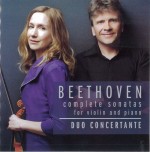 There’s a lovely new 3-CD set of the Beethoven Complete Sonatas for Violin and Piano from Canada’s own Duo Concertante, violinist Nancy Dahn and pianist Timothy Steeves (Marquis MAR 81517). The two have been playing together since 1997 — Beethoven’s “Kreutzer Sonata” was the first thing they played together, and they took their duo name from the composer’s inscription above the title — and the Beethoven sonatas have apparently always been a part not just of their repertoire, but of their daily lives. My first impressions were that for all the clean playing and fine ensemble work these were still fairly low-key performances, but they quickly won me over. By the second CD, with lovely readings of the “Spring” and “Kreutzer” sonatas placed around the Sonata in A major Op.12, No.2, I was more than convinced.
There’s a lovely new 3-CD set of the Beethoven Complete Sonatas for Violin and Piano from Canada’s own Duo Concertante, violinist Nancy Dahn and pianist Timothy Steeves (Marquis MAR 81517). The two have been playing together since 1997 — Beethoven’s “Kreutzer Sonata” was the first thing they played together, and they took their duo name from the composer’s inscription above the title — and the Beethoven sonatas have apparently always been a part not just of their repertoire, but of their daily lives. My first impressions were that for all the clean playing and fine ensemble work these were still fairly low-key performances, but they quickly won me over. By the second CD, with lovely readings of the “Spring” and “Kreutzer” sonatas placed around the Sonata in A major Op.12, No.2, I was more than convinced.
There are certainly more high-powered versions available — the Ibragimova/Tiberghien Wigmore Hall set I reviewed in December 2011, for example — but the sensitivity and musical intelligence of these performances more than compensate for any lack of sheer technical fireworks. Dahn and Steeves play these wonderful sonatas as if they are visiting old friends, and the sense of intimacy and emotional involvement is palpable throughout the three discs.
I’ve received several CDs of the Bach Sonatas & Partitas for Solo Violin BWV 1001-1006 over the past few months, all of which feature some quite stunning playing. There are two complete 2-CD sets and one half-set.
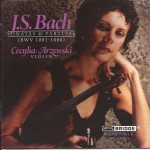 Cecylia Arzewski, whose performances are available on Bridge Records (9358A/B), enjoyed a stellar orchestral career with the Boston Symphony, the Cleveland Orchestra and the Atlanta Symphony for almost 40 years. Her playing here is of the highest quality — warm, sensitive, intelligent, and with a great feel for phrasing and tempo; even in the fastest movements there is always a clear sense of pulse, and room to breathe at the beginnings and endings of phrases. Rhythmic articulation is crisp and clear, the multiple stopping handled with clarity and apparent ease, and the sense of line always secure.
Cecylia Arzewski, whose performances are available on Bridge Records (9358A/B), enjoyed a stellar orchestral career with the Boston Symphony, the Cleveland Orchestra and the Atlanta Symphony for almost 40 years. Her playing here is of the highest quality — warm, sensitive, intelligent, and with a great feel for phrasing and tempo; even in the fastest movements there is always a clear sense of pulse, and room to breathe at the beginnings and endings of phrases. Rhythmic articulation is crisp and clear, the multiple stopping handled with clarity and apparent ease, and the sense of line always secure.
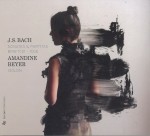 Exactly the same can said for the complete recording by the French Baroque specialist Amandine Beyer (Zig-Zag Territoires ZZT110902), although there is a somewhat lighter tone and an added rhythmic snap and vitality to her playing that makes it an even more rewarding listen; even the Sonata movements have a dance feel to them. The one major difference — not immediately apparent unless you have perfect pitch or play the two versions back-to-back — is that Beyer apparently tunes to Baroque pitch, so her performances are a semi-tone lower than Arzewski’s.
Exactly the same can said for the complete recording by the French Baroque specialist Amandine Beyer (Zig-Zag Territoires ZZT110902), although there is a somewhat lighter tone and an added rhythmic snap and vitality to her playing that makes it an even more rewarding listen; even the Sonata movements have a dance feel to them. The one major difference — not immediately apparent unless you have perfect pitch or play the two versions back-to-back — is that Beyer apparently tunes to Baroque pitch, so her performances are a semi-tone lower than Arzewski’s.
Beyer’s set also includes a Solo Sonata by Johann Georg Pisendel, a German virtuoso and exact contemporary of Bach’s; the two met in 1709, and Pisendel may (depending on which set of booklet notes you choose to believe) have owned a copy of Bach’s Sonatas & Partitas, and may even have influenced their composition.
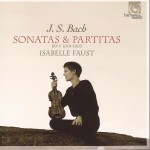 The half-set is the second volume of the complete recording by Isabelle Faust, now available on harmonia mundi HMC 902124; the three works, however, are the first half of the set of six. Again, there is wonderful playing here, with some terrific presto movements, relaxed and almost meditative slower movements, and clean, beautifully controlled playing in the fugues.
The half-set is the second volume of the complete recording by Isabelle Faust, now available on harmonia mundi HMC 902124; the three works, however, are the first half of the set of six. Again, there is wonderful playing here, with some terrific presto movements, relaxed and almost meditative slower movements, and clean, beautifully controlled playing in the fugues.
Perhaps surprisingly — or maybe not, given the huge advances in the understanding of period performance techniques — all three performers take essentially the same approach to the choices of ornamentation and the interpretation of some of the chordal configurations, although obviously there are some differences in tempo, bowing and phrasing.
If you are interested in these wonderful works you probably already own one or more versions; if you do, you can add any one of these to your collection without reservation. In an interesting aside on the issue of modern or period instrument, Arzewski says that her goal was to be as true as possible, using a modern (my italics) violin and bow, to Bach’s style, although her instrument is the 1714 Petrus Guarneri of Mantua, which in its original condition pre-dates the Sonatas & Partitas themselves. Beyer, meanwhile, plays a Baroque violin, but one made by Pierre Jaquier in 1996, with an Eduardo Gorr bow from 2000; both were made over 275 years after the works were written.
 There is more outstanding Bach playing from the ever-reliable Jennifer Koh on Bach & Beyond Part 1, her latest CD from Cedille Records (CDR 90000 134). I’ve commented before on Koh’s imaginative programming as well as her marvellous playing, and this CD is more than up to her own high standards. It records the first of a three-part series of recital programs that Koh initiated in 2009 to explore the history of solo violin works from Bach to the present day. Each recital features two of the Bach Sonatas & Partitas paired with solo compositions from the subsequent centuries.
There is more outstanding Bach playing from the ever-reliable Jennifer Koh on Bach & Beyond Part 1, her latest CD from Cedille Records (CDR 90000 134). I’ve commented before on Koh’s imaginative programming as well as her marvellous playing, and this CD is more than up to her own high standards. It records the first of a three-part series of recital programs that Koh initiated in 2009 to explore the history of solo violin works from Bach to the present day. Each recital features two of the Bach Sonatas & Partitas paired with solo compositions from the subsequent centuries.
I really can’t say enough about Koh’s playing or her programming; it’s a perfect marriage of ability and intellect that puts her on a different level than most performers, and this CD is a classic example of that. It opens with Bach’s E Major Partita No.3, which is followed by Ysaÿe’s Sonata No.2, a work which quotes both the preceding Bach Partita and the Dies Irae chant. Kaija Saariaho’s short Nocturne, a tribute and memorial to the composer Witold Lutosławski, also quotes the E Major Partita and the Dies Irae, while Missy Mazzoli’s Dissolve, O My Heart (the title is taken from Bach’s St. John Passion) takes its material cue from the Chaconne from Bach’s Partita No.2 in D Minor. The complete D Minor Partita fittingly closes a marvellous CD that Koh describes as a journey from light through darkness, and back to light.
The playing throughout is exemplary, with a wonderful purity in the Bach and a clear empathy in the contemporary works. The remaining two volumes of this fascinating project should be well worth waiting for.
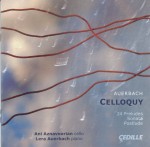 The Cedille label is dedicated to promoting musicians from the Chicago area, and cellist Ani Aznavoorian is joined by the composer on another new issue, Celloquy, which features the music of the Russian-born American Lera Auerbach (CDR 90000 137). Auerbach is a prodigiously talented individual: a concert pianist, composer, librettist, author and visual artist. Two of her poems are featured in the CD booklet. The three cello and piano works here are the 24 Preludes,the Cello Sonata and the brief
The Cedille label is dedicated to promoting musicians from the Chicago area, and cellist Ani Aznavoorian is joined by the composer on another new issue, Celloquy, which features the music of the Russian-born American Lera Auerbach (CDR 90000 137). Auerbach is a prodigiously talented individual: a concert pianist, composer, librettist, author and visual artist. Two of her poems are featured in the CD booklet. The three cello and piano works here are the 24 Preludes,the Cello Sonata and the brief
The 24 Preludes from 1999 are short, virtuosic and extremely effective pieces that explore the extreme ranges of both instruments. Auerbach writes that “re-establishing the value and expressive possibilities of all major and minor tonalities is as valid at the beginning of the 21st century as it was during Bach’s time.” This is especially true given the way that tonality has been treated over the past 100 years or so, and she certainly covers a good deal of stylistic ground in the Preludes. No.12 is a simply beautiful melody, albeit one with disturbing undertones; No.13 is a Bach-style cello solo; No.14 is a diabolic variation on Mozart’s Magic Flute Overture; No.16 is a grotesque waltz. No.24 quotes the themes from all the preceding movements, “as in a final stream of memories,” in the words of the excellent booklet
The Cello Sonata is another terrific piece, written in 2002. Again, warm, lyrical passages are found alongside sections of dissonant and technically challenging writing, in what is clearly a very emotional work. The Postlude is a reprisal of No.12 of the Preludes, but with a prepared piano that gives the music a distorted and quite bleak sound; it’s a haunting ending to a simply outstanding CD.
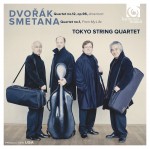 At the time of writing, the renowned Tokyo Quartet has just given its farewell performances in Toronto, a city it has visited some 45 times during its long career. Its final concert will be at Yale University in June. The ensemble’s farewell CD of quartets by Dvořák and Smetana has just been issued by harmonia mundi (807429), with impassioned performances of Dvořák’s Quartet No.12, Op.96 (“The American”) and Smetana’s painfully personal Quartet No.1 in E minor, “From My Life.” It certainly wasn’t their final recording, however. While these quartets were recorded in 2006, the glorious performance of the autumnal Brahms Clarinet Quintet, also on the harmonia mundi label and reviewed here last December, was recorded in 2011, and if anything, has a much greater feeling of wistful farewell about it. Still, either CD will stand as a testament to the standard this remarkable group attained, and to the loss their retirement represents to the chamber music world.
At the time of writing, the renowned Tokyo Quartet has just given its farewell performances in Toronto, a city it has visited some 45 times during its long career. Its final concert will be at Yale University in June. The ensemble’s farewell CD of quartets by Dvořák and Smetana has just been issued by harmonia mundi (807429), with impassioned performances of Dvořák’s Quartet No.12, Op.96 (“The American”) and Smetana’s painfully personal Quartet No.1 in E minor, “From My Life.” It certainly wasn’t their final recording, however. While these quartets were recorded in 2006, the glorious performance of the autumnal Brahms Clarinet Quintet, also on the harmonia mundi label and reviewed here last December, was recorded in 2011, and if anything, has a much greater feeling of wistful farewell about it. Still, either CD will stand as a testament to the standard this remarkable group attained, and to the loss their retirement represents to the chamber music world.
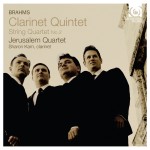 There is another beautiful recording of the Brahms Clarinet Quintet, again on the harmonia mundi label, this time by the Jerusalem Quartet with clarinettist Sharon Kam (HMC 902152). It’s a bit breathy at times, but very warm, albeit with not quite the same wistfulness as the Tokyo Quartet version with Jon Manasse, mentioned above. The string playing in particular is really quite lovely. There is equally gorgeous playing in the Brahms String Quartet No.2 in A minor, Op.51 No.2. This is full-blooded Brahms, rich and expansive, warm and passionate, thoughtful and contemplative, and with a wonderful dynamic range.
There is another beautiful recording of the Brahms Clarinet Quintet, again on the harmonia mundi label, this time by the Jerusalem Quartet with clarinettist Sharon Kam (HMC 902152). It’s a bit breathy at times, but very warm, albeit with not quite the same wistfulness as the Tokyo Quartet version with Jon Manasse, mentioned above. The string playing in particular is really quite lovely. There is equally gorgeous playing in the Brahms String Quartet No.2 in A minor, Op.51 No.2. This is full-blooded Brahms, rich and expansive, warm and passionate, thoughtful and contemplative, and with a wonderful dynamic range.



